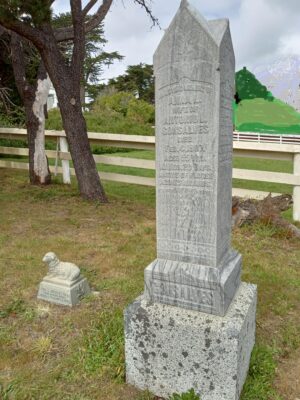As I was strolling through Hillcrest Cemetery the other day, I counted up all the languages spoken by the people buried there. In the early days, immigrants came to the Mendocino Coast from nearly every corner of the world, leaving behind their mother lands, but bringing with them their mother tongues. Judging from the birthplaces inscribed in the tombstones in Hillcrest, you could have heard snatches of Portuguese, Italian, Finnish, Cantonese, Swedish, Danish, and German in the course of a two or three-block walk through Mendocino.

Next to the gravestone of Antonio and Anna Gonsalves, who came from the island of Flores in the Azores, is the diminutive stone of their son, Joe.
How did they get along—with each other and in this gritty new place? People just off the boat from the island of Flores in the Azores, or Uleahorg in northern Finland, or Guangdong Province in China, or Mozzio in the Piemonte region of Italy spoke mostly their own dialects and did not have the most recent edition of the West Coast Lumberjack English phrase book, if they could even read. Not only did they have to carve out a life here in northwest nowhere, but they had to do it in a new language.
English was the language of the mill owners and the other moneyed classes in town, so it was the ticket to work and wage earning, the lingua franca of trade and commerce; it was the main source of individual choice and freedom, which after all was what the immigrants came here for. There was also a bias against greenhorns: those who had arrived first and spoke English felt superior to recent arrivals who did not. The newcomers must have felt a certain urgency to escape that prejudice.
Nowadays, we call their approach to language learning “immersion.” At work or at the stores exchanges most often happened in English with everyone using what words they knew. They “negotiated meaning” in order to reach a clear understanding with each other. It’s too bad there were no linguists around with tape recorders and note pads to capture the exchanges.
At the end of a long, hard day speaking a foreign language it must have been a huge relief to go home and speak a familiar tongue, or to drop in at the ethnic fraternal groups that flourished here for various reasons, prime among them the basic human need to have someone to talk to. The traditional holiday observances and church dinners were fun and relaxing.
While their parents were struggling with the new language, their children were acquiring it without much effort. The first children born to the new arrivals soaked up mama and papa’s language at home, and soon they started to pick up the local vernacular from their little playmates.
When they went to school, they were taught “standard” English. Soon they were bilingual and, if they were anything like first-generation children of immigrants everywhere, they began to act as translators for their parents, decoding both the new language and the new culture for them. Their parents may have relied on them and been proud of their accomplishments, but a painful change was in the sea breeze.
Native-born sons and daughters found much in common with their schoolmates, friends, and neighbors from different ethnic backgrounds. They spoke American together and some young people began to resist speaking the language of their parents. Whether or not assimilation was parentally encouraged, it happened. It wasn’t long before the first-generation teenagers started dating their schoolmates and, as these things go, marrying them. Finns married Swedes, Portuguese married Italians, Irish married Yankees, and the mother tongues began to fade to where they are today: on tombstones in Hillcrest Cemetery.
To learn more about the immigrants who settled Mendocino, visit the Kelley House Museum Thursdays through Sundays, or contact the museum staff at (707) 937-5791.